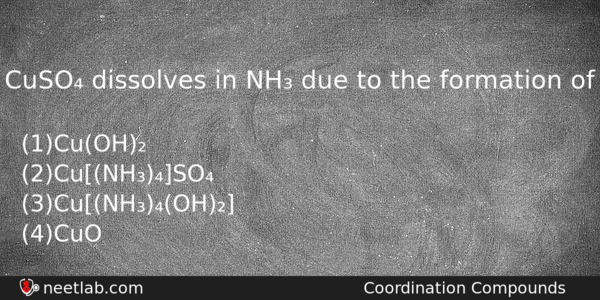| ⇦ | 
| ⇨ |
CuSO₄ dissolves in NH₃ due to the formation of
Options
(a) Cu(OH)₂
(b) Cu[(NH₃)₄]SO₄
(c) Cu[(NH₃)₄(OH)₂]
(d) CuO
Correct Answer:
Cu[(NH₃)₄(OH)₂]
Explanation:
NH₃+ H₂O→ NH₄OH
CuSO₄ + NH₄OH → Cu(OH)₂ + (NH₄)₂ SO₄ / Cu(OH)₂ + 2NH₄OH + (NH₄)₂ SO₄ → [Cu (NH₂)₄] SO₄ + 4 H₂O ( Tetrammine cupric sulphate
The complex is called as Schotzer’s reagent which is used for dissolving cellulose in the manufacture of artificial silk.
Related Questions: - The hybridisation of carbons of C-C single bond of HC ≡C-CH =CH₂ is
- The elements having the electronic configuration [Kr] 4d¹°f¹⁴,5s² p⁶d²,6s² belongs
- Order of reaction is decided by
- Which one of the following compounds exhibit both schottky and frenkel defects
- The compound which does not exist as hydrate form
Topics: Coordination Compounds
(87)
Subject: Chemistry
(2512)
Important MCQs Based on Medical Entrance Examinations To Improve Your NEET Score
- The hybridisation of carbons of C-C single bond of HC ≡C-CH =CH₂ is
- The elements having the electronic configuration [Kr] 4d¹°f¹⁴,5s² p⁶d²,6s² belongs
- Order of reaction is decided by
- Which one of the following compounds exhibit both schottky and frenkel defects
- The compound which does not exist as hydrate form
Topics: Coordination Compounds (87)
Subject: Chemistry (2512)
Important MCQs Based on Medical Entrance Examinations To Improve Your NEET Score
18000+ students are using NEETLab to improve their score. What about you?
Solve Previous Year MCQs, Mock Tests, Topicwise Practice Tests, Identify Weak Topics, Formula Flash cards and much more is available in NEETLab Android App to improve your NEET score.
Share this page with your friends

Leave a Reply